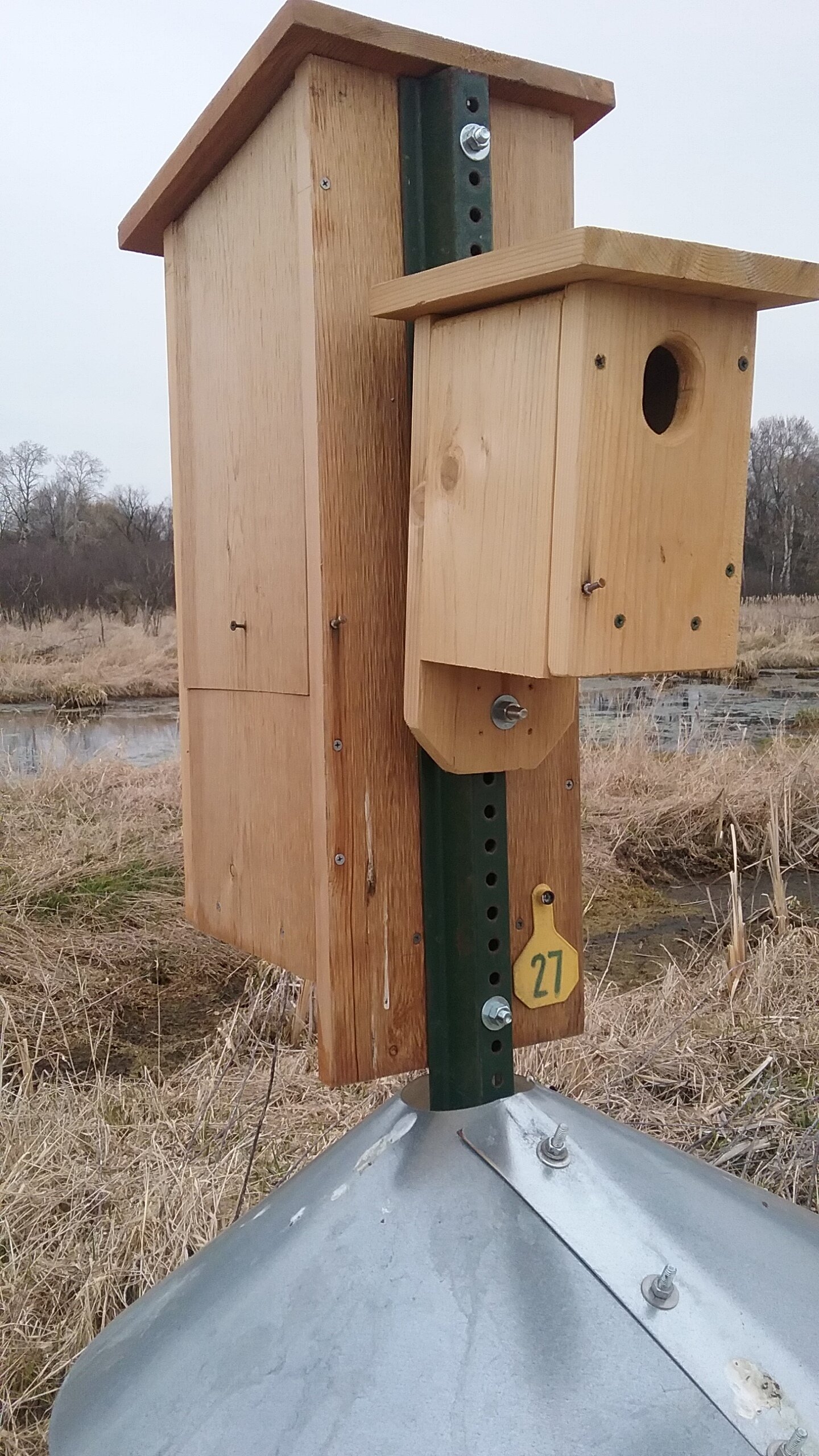“They covered the entire sky.” - Aaron Holschbach. Photo of just part of the flock shown here, by Aaron.
Aaron Holschbach set a new tree swallow record for Columbia County with his eBird entry for Harvey-Wangsness Road Wetland (4 miles southeast of Goose Pond) on September 15. His eBird data entry included two photos of “Probably the largest flock of swallows I have ever seen, and it was over 90% Tree Swallows. Tried counting a group of 100 and estimated about 40 groups this size, but likely even more than 4,000.” He estimated the number of tree swallows at 4,000.
The record high count for tree swallows at Goose Pond is held by Ted Keyel who reported 1,000 on September 2, 2012. The Wisconsin record of 50,000 was reported on August 27, 1977, at Green Bay by D. K. Gustafson.
Tree swallow photo by Kelly Colgan Azar
The Cornell Lab of Ornithology reports that, “Tree Swallows are common but overall populations declined by 49% between 1966 and 2014, according to the North American Breeding Bird Survey. During this same period, though the species decreased in the east and west, populations in central North America increased. Partners in Flight estimates a global breeding population of 17 million. This bird's numbers are probably most limited by available nest sites, and as people put up more nest boxes their range has been expanding, particularly southward.
Natural cavities, where most Tree Swallows build their nests, have been disappearing for the past 200 years as people clear the land, manage woodlands, cut down older trees, and remove dead trees. Tree Swallows eat a high-insect diet, which through bioaccumulation can expose them to high levels of pesticides and other contaminants such as PCBs and mercury. They also show a sensitive response to climate change. As spring temperatures have warmed since the 1960s, Tree Swallows’ average date of laying their first egg has moved nine days earlier in the year.”
Tree swallow nest. Photo by Mark Martin
We are trying to help increase tree swallow numbers. Graham, Goose Pond Sanctuary land steward, coordinated the following volunteers: Amy Ihlenfeldt and Frank Iltis, Bob and Gerry Bennicoff, JD Arnston, Mark and Jenny McGinley, Nancy Piraino and Rachel Barker, all who monitored a total of 90 nest boxes at Goose Pond and Erstad Prairie this summer and reported that 394 tree swallows fledged.
The highlight was JD’s observation of a nest of eight eggs and all fledged. In our many years of monitoring tree swallow we never had a nest with eight eggs. Most clutches contain six young and range between three and seven. Tree swallow nests begin with a grass lining much like a bluebird nest; however, it does not take long for swallows to add feathers to the nests. In wetland areas wood duck and Canada goose feathers are often used.
Tree swallows on the front, wood ducks on the back, with a predator guard underneath. Photo by Mark Martin
We maintain and monitor 40 nest boxes at our Wildland property near Rio. This year tree swallows nested in 28 boxes including raising two families in two boxes. Tree swallows laid 158 eggs, and 135 fledged. We lost three nests with eggs to raccoons even though we had Noel wire predator guards on the front of the boxes or greased the poles. We did not have any predation on boxes that were attached on the same pole with a wood duck box and protected with a metal cone guard.
Tree swallows are one of our favorite cavity nesters. We will always remember our tree swallow sightings in Churchill, Manitoba while on a natural history tour in 1992 led by Bill Volkert and Connie Ratham that included the longest day of the year. We wondered how the tree swallow we observed could survive in harsh conditions with one inch of snow, a record low temperature of -2 degrees C (28 degrees F), and high winds.
We encourage people to erect nest boxes for our feathered friends or help out by monitoring nest box trails at Goose Pond or Erstad Prairie. Check out the Bluebird Restoration Association of Wisconsin for more information on cavity nesters.
Cool Facts from Cornell Lab of Ornithology
Migrating and wintering Tree Swallows can form enormous flocks numbering in the hundreds of thousands. They gather about an hour before sunset and form a dense cloud above a roost site (such as a cattail marsh or grove of small trees), swirling around like a living tornado. With each pass, more birds drop down until they are all settled on the roost.
Tree Swallows winter farther north than any other American swallows and return to their nesting grounds long before other swallows come back. They can eat plant foods as well as their normal insect prey, which helps them survive the cold snaps and wintry weather of early spring.
The Tree Swallow—which is most often seen in open, treeless areas—gets its name from its habit of nesting in tree cavities. They also take readily to nest boxes.
Tree Swallows have helped researchers make major advances in several branches of ecology, and they are among the best-studied bird species in North America. Still, we know little about their lives during migration and winter.
Written by Mark Marin and Susan Foote-Martin, Goose Pond Sanctuary resident managers
Cover photo by Andy Reago & Chrissy McClarren









